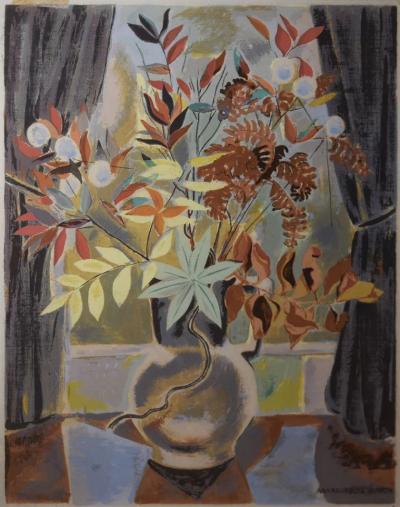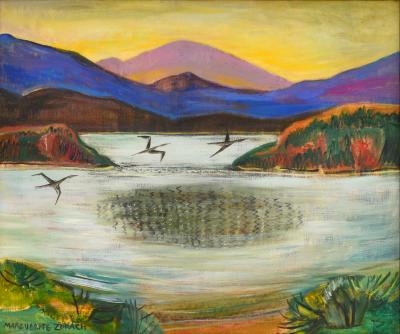Marguerite T. Zorach
American, 1887 - 1968
Born in Santa Rosa, California, in 1887, Marguerite Zorach was drawn to art at an early age and began her studies in Paris at the insistence of her aunt, artist Harriet Adelaide Harris, who lived there and whose connections enabled her young niece to associate with some of the most innovative minds of the day, including Gertrude Stein and Pablo Picasso. In Paris, Marguerite first enrolled at the Académie de la Grande Chaumière before shifting to the more progressive program at the Académie de La Palette from 1908 to 1911, where she would meet her husband, fellow student William Zorach. At La Palette, Marguerite came under the tutelage of the Post-Impressionist John Duncan Fergusson and she soon developed the Fauvist tendencies that became a common thread for her art throughout her career. Her early works are notable for their strong black outlines and bold, chromatic palette, elements clearly at play in Open Market, painted circa 1909, where she interprets the flurry of activity amid vendors and customers clustered among the stalls. Marguerite exhibited at the Salon d’Autumne and with the Société des Artistes Indépendants in Paris in 1911, and at the end of her studies, traveled with her aunt throughout the Middle East and Asia, with stays in Egypt, Palestine, India and later Japan, before returning home to California by the spring of 1912.
Back in the States, Marguerite embarked on bringing the avant-garde concepts she had learned in France to an American audience, instilling dynamic compositional forms and intense color schemes in her work, with the grand vistas of Yosemite and natural beauty of the Sierra Mountains often serving as inspiration. After marrying William Zorach in December of 1912, the pair resided in an apartment in Greenwich Village, dubbed their ‘Post-Impressionistic Studio,’ but at Marguerite’s insistence they spent the warmer months in the country. She valued these breaks from city life and was able to sustain her connection to Nature through trips to Chappaqua, New York, Provincetown, Massachusetts, and eventually Georgetown, Maine, where they would establish a permanent summer home in 1923. Both Zorachs took part in the ground-breaking Armory Show of 1913, the first major exhibition on American soil to feature French modernist painters at the forefront of Cubism, Fauvism, and Symbolism. Despite the critics’ outspoken disdain for the show and the radical new philosophies it espoused, the sensational response caught the attention of serious collectors and the Zorachs and many of their brethren continued working in this vein, becoming pioneers for the modernist movement in America.
Following the birth of her two children in 1915 and 1917, Zorach found it difficult to devote as much time to her painting and began applying her creativity to textiles, producing tapestries and embroideries that retained her rich color palette and keen sense of design. In 1923, Montross Gallery in New York mounted one of her first solo exhibitions of wool tapestries to positive reviews and strong sales among New York’s influential families, and many of these unique pieces are now in the collections of major museums across the country. Zorach resumed her painting in the 1930s, and throughout her life remained an active exhibitor at a variety of New York venues, including Downtown Gallery and Kraushaar Galleries, in addition to showing with the Society of Independent Artists and becoming a founder of the Society of Women Artists in 1925. Nationally, she took part in exhibitions at the Pennsylvania Academy and the Corcoran Gallery in Washington, DC, and created several murals for the Works Progress Association in the 1930s. Today, Zorach’s paintings and textiles can be found in a number of prominent museum collections, including the Metropolitan Museum of Art, the Museum of Fine Arts, Boston, the Smithsonian American Art Museum, the Colby College Museum of Art in Waterville, Maine, and the Addison Gallery of American Art in Andover, Massachusetts.
Back in the States, Marguerite embarked on bringing the avant-garde concepts she had learned in France to an American audience, instilling dynamic compositional forms and intense color schemes in her work, with the grand vistas of Yosemite and natural beauty of the Sierra Mountains often serving as inspiration. After marrying William Zorach in December of 1912, the pair resided in an apartment in Greenwich Village, dubbed their ‘Post-Impressionistic Studio,’ but at Marguerite’s insistence they spent the warmer months in the country. She valued these breaks from city life and was able to sustain her connection to Nature through trips to Chappaqua, New York, Provincetown, Massachusetts, and eventually Georgetown, Maine, where they would establish a permanent summer home in 1923. Both Zorachs took part in the ground-breaking Armory Show of 1913, the first major exhibition on American soil to feature French modernist painters at the forefront of Cubism, Fauvism, and Symbolism. Despite the critics’ outspoken disdain for the show and the radical new philosophies it espoused, the sensational response caught the attention of serious collectors and the Zorachs and many of their brethren continued working in this vein, becoming pioneers for the modernist movement in America.
Following the birth of her two children in 1915 and 1917, Zorach found it difficult to devote as much time to her painting and began applying her creativity to textiles, producing tapestries and embroideries that retained her rich color palette and keen sense of design. In 1923, Montross Gallery in New York mounted one of her first solo exhibitions of wool tapestries to positive reviews and strong sales among New York’s influential families, and many of these unique pieces are now in the collections of major museums across the country. Zorach resumed her painting in the 1930s, and throughout her life remained an active exhibitor at a variety of New York venues, including Downtown Gallery and Kraushaar Galleries, in addition to showing with the Society of Independent Artists and becoming a founder of the Society of Women Artists in 1925. Nationally, she took part in exhibitions at the Pennsylvania Academy and the Corcoran Gallery in Washington, DC, and created several murals for the Works Progress Association in the 1930s. Today, Zorach’s paintings and textiles can be found in a number of prominent museum collections, including the Metropolitan Museum of Art, the Museum of Fine Arts, Boston, the Smithsonian American Art Museum, the Colby College Museum of Art in Waterville, Maine, and the Addison Gallery of American Art in Andover, Massachusetts.
Marguerite Zorach Born California, 1887 Died New York, 1968 Marguerite Thompson Zorach was a Fauvist painter, textile artist and graphic designer. From 1908-1911, she studied in Paris at the progressive school, La Palette. During this time she met her husband-to-be, William Zorach. In 1912, after returning to the United States, the couple married. They lived in Greenwich Village and worked closely together on many paintings. Zorach did not fully receive critical acclaim as an American painter until after her death in 1970, when many of her earlier canvases were rediscovered. Although her fame was post-humus, she had a number of profound accomplishments within her lifetime. Both she and her husband exhibited their art in the 1913 Armory Show in New York (a show that helped to change the way Americans view art), and she was elected Director of the Society of Independent Artists and was the first President of the New York Society of Women Artists. Works Held: National Museum of American Art; Metropolitan Museum of Art; Whitney Museum of American Art; Newark Museum; Brooklyn Museum; Colby College; Speed Museum; Massillon Museum; Federal Art Project of the Works Progress Administration Murals; United States Post Office, Peterborough, New Hampshire; Ripley, Tennessee; Monticello, Illinois. Exhibitions: Salon d'Automne, 1908, 1911; Society of Independent Artists, Paris, 1911; Society of Independent Artists, New York, 1917-18, 1921-24, 1941; Royar Galleries, Los Angeles, solo, 1912; Amory Show, 1913; Contemporaries, New York, solo, 1913; Playhouse, Cleveland, 1913; Daniel Gallery, New York City, 1915-16, 1918; Pan-Pacifico Expo, San Francisco, (medal, 1915); Forum Exhibit, New York City, 1916 (only woman to exhibit); Dayton Museum of Art, 1922; Salons of America, 1922-36); Montross Gallery, New York City, solo, 1923; Downtown Gallery, New York, solo, 1928, 30, 34; C.W. Kraushaar,1953, 57, 62; Art Institute of Chicago, 1926-49. Further Reading: Who Was Who in American Art 1564-1975: 400 Years of Artists in America, Vol. 1. Peter Hastings Falk, Georgia Kuchen and Veronica Roessler, eds., Sound View Press, Madison, Connecticut, 1999. 3 Vols. (Original Listing 1940); An Encyclopedia of Women Artists of the American West, Phil Kovonick, Marian Yoshiki-Kovnick, University of Texas Press, Austin, 1999, 3rd Edition.; Artists in California (1786-1940), Edan Milton Hughs, Hughs Publishing Company, San Francisco, 1986, 1st edition. Biography courtesy of David Cook Galleries
Marguerite Thompson Zorach was born in Santa Rosa, CA on Sept. 25, 1887. She was raised in Fresno and showed artistic promise at age three. A brilliant student, she was one of the first women admitted to Stanford University in 1908. Shortly after her enrollment, she was lured to Paris by an aunt who was living there. She studied art for four years in Paris and, while there, met her future husband William Zorach. Returning to Fresno in 1912, she camped with her family in the Sierra Madre and did a series of paintings of that area. The following year, she returned to NYC, married Zorach, and lived in Brooklyn for her remaining years. A pioneer in modern art, she was one of the few young artists to introduce Fauvist and Cubist styles to the U.S. between 1910-20. The Zorachs made another trip to Yosemite in 1920. She died in Brooklyn on June 27, 1968. Exh: Paris Salon, 1911; Royer Gallery (LA), 1912; Armory Show, 1913; PPIE, 1915; AIC, 1920 (medal); Century of Progress (Chicago), 1933. In: MM; Fresno Federal Bldg; NMAA; MOMA; Whitney Museum; Newark Museum; Brooklyn Museum; Speed Museum (Louisville). Source: Edan Hughes, "Artists in California, 1786-1940" American Art Annual 1915-33; Who's Who in American Art 1936-66; Dictionaire des Peintres, Sculpteurs, Dessinateurs, et Graveurs (Benezit, E); American Women Artists (Rubenstein); Women Artists in America (Collins & Opitz); Artists of the American West (Samuels); NY Times, 6-29-1968 (obituary).Biography courtesy of Roughton Galleries
Marguerite Zorach was a pioneer American Modernist and was one of the first artists to introduce Fauvism and Cubism to America (1910-20). She studied briefly at Stanford (1908) before moving to Paris to study at Grande Chaumiere (1908) and La Palette (1908-11). After her study abroad Zorach returned to her Fresno home and produced Fauvist landscapes in bright orange, crimson and purple with thick black outlines. In 1912 Zorach married and moved to Greenwich Village. She continued to paint in the Fauvist style in 1915 when she incorporated a Cubist structure into her landscapes.
After Zorach gave birth to her two children, she shifted her artistic focus to embroidery of stylized Arcadian scenes. The large tapestries were produced after 1920. In the 1930s, Zorach created two large murals for the WPA depicting farm hands picking grapes. However, the officials rejected her work in favor of something more traditional. Only a small group of her paintings remain after she moved from CA. After her death they were restored and exhibited.
Biography courtesy of The Caldwell Gallery, www.antiquesandfineart.com/caldwell
After Zorach gave birth to her two children, she shifted her artistic focus to embroidery of stylized Arcadian scenes. The large tapestries were produced after 1920. In the 1930s, Zorach created two large murals for the WPA depicting farm hands picking grapes. However, the officials rejected her work in favor of something more traditional. Only a small group of her paintings remain after she moved from CA. After her death they were restored and exhibited.
Biography courtesy of The Caldwell Gallery, www.antiquesandfineart.com/caldwell





















